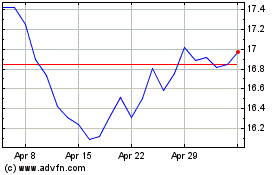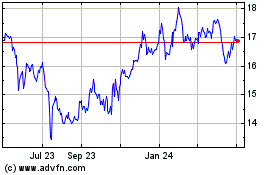Brutal price competition is rippling through profits, inflation
and antitrust
By Ryan Knutson
This article is being republished as part of our daily
reproduction of WSJ.com articles that also appeared in the US print
edition of The Wall Street Journal (June 24, 2017).
Customers are used to cellphone bill shock, but not like
this.
The cost of U.S. cellular service is rapidly plunging, reversing
years of increases that have squeezed consumers' budgets and
generated huge profits for wireless companies.
Americans are using their smartphones more than ever to stream
videos, surf the web and browse Facebook. But telecommunications
companies are losing their power to raise prices for using their
networks, in part because the U.S. cellphone market is nearing
saturation. That has kicked off a vicious price war among the four
national wireless carriers.
The consumer-price index for wireless phone service, an
indicator of current offers from cellphone service providers,
dropped 12.5% in May from a year ago, according to the Labor
Department. The index earlier fell 13% in April, the largest
decline in the history of the category, prompting Federal Reserve
Chairwoman Janet Yellen to say earlier this month it was a factor
in the country's low inflation.
Beyond the consumer impact, the rapid collapse in the industry's
pricing power will ripple through its profit margins, federal
regulations and antitrust law.
T-Mobile US Inc. and Sprint Corp., the third and fourth largest
carriers, recently rekindled talks about a merger, according to
people familiar with the matter. The two previously discussed
combining in 2014 but backed down in the face of regulatory
opposition.
The rout could continue when the many consumers who haven't felt
the effects of price drops, unaware they can lower their monthly
bills, call their carriers to demand better deals.
Selina Sosa, who runs a nonprofit near Dallas, cut her monthly
bill by about a third in less than six months. Last December, she
switched carriers from AT&T Inc. to Verizon Communications
Inc., reducing her payment for three phones from $330 to $279.
In April, Ms. Sosa called Verizon with a billing question and an
agent offered to switch her into an unlimited-data plan and lower
her monthly bill by another $57. "I didn't even ask to reduce my
payment," she said, adding she was relieved to save the extra
cash.
Six years ago, the number of active cellphones surpassed the
U.S. population. About 80% of Americans currently own a smartphone,
according to CTIA, an industry trade group. Many have multiple
devices. Consumers are also keeping their smartphones for longer
periods, which means fewer customers are up for grabs.
Offers from wireless providers are becoming increasingly
extreme. Sprint this month launched a short-term promotion to give
away a free year of wireless service to new customers who supply
their own mobile phones. The move comes months before Apple Inc. is
expected to introduce its newest iPhone, which is when carriers
typically roll out discounts.
The competition grew so intense during the first three months of
this year that Verizon, the largest national carrier, suffered its
first-ever quarterly subscriber loss. AT&T Inc. and Sprint also
lost customers, and the industry's total revenue growth slowed to
1% from a year ago, its lowest-ever rate, according to research
from investment bank UBS. The quarter's big winner was T-Mobile,
which has been offering plans with favorable features.
A major reason for the steep decline in the wireless
consumer-price index is companies' return to unlimited-data plans.
Back in 2010 and 2011, AT&T and Verizon ended their
all-you-can-eat plans for smartphone customers and imposed monthly
caps on usage. Executives for years said unlimited plans made
little economic sense.
In February, Verizon brought back unlimited plans to counter a
wave of customer defections to T-Mobile and Sprint, which had both
rolled out aggressive unlimited offers. Days later, AT&T
responded with a new unlimited plan of its own. With the new plans,
making calls and texting are essentially free. Expensive overage
fees that carriers impose when users exceed their monthly usage
limit are also going away.
Verizon now charges $80 a month for an unlimited talk, text and
data plan for a single line. Sprint charges $50 for a similar plan
in the first year. In 2011, an unlimited Verizon plan cost $120 and
one from Sprint cost $110.
Verizon Chief Executive Lowell McAdam said at a conference in
May that adopters of its current unlimited plan are mostly people
who used to have pricier subscriptions. He also predicts many
customers with lower-price, capped-data plans will soon start
paying more for unlimited service to avoid having to keep track of
their monthly data usage.
"There are ebbs and flows for sure," said Jeffrey Moore, head of
Wave7 Research, which tracks wireless competition, "but I think
that the past year has been the most aggressive time in wireless
history."
Cellphones are a major expense for many families. The average
American household spent $1,074 for cellular service in the year to
June 2016, up 77% from a decade earlier. Total household
expenditures rose just 13% over that same period, according to
Labor Department data.
If many people wind up paying less for their cellphone bills, it
could free up consumer spending in other areas, similar to how a
decline in gasoline prices can boost other parts of the
economy.
For much of the past year, Niya Case, a human-resources
specialist who lives near Tampa, Fla., was paying about $400 a
month for four smartphones and two tablets, which belonged to her
and family members.
"Oh my God, people pay less than that for a brand-new car," the
38-year-old said she used to think when she looked at her bill from
Sprint.
Ms. Case said she asked friends about less expensive offers and
decided to switch providers a few weeks ago. She is now paying
about $155 a month for four phone lines at T-Mobile and plans to
put the savings toward school clothes for her children and a family
cruise in the fall.
The changes have been punishing for wireless companies. After
rising every quarter for 17 years, revenue from wireless data plans
fell 0.33% in the first quarter of this year, according to industry
consultant Chetan Sharma.
The slowdown is making companies look outside the industry for
growth. AT&T plans to buy Time Warner Inc. for $85 billion,
while Verizon has scooped up Yahoo and AOL to build a digital media
business.
Some economists believe consolidation among the four national
carriers could end the price war, because three competitors with
roughly equal market share would behave less aggressively to
maintain the status quo.
During a call with analysts last month, Sprint Chairman
Masayoshi Son said he was looking to merge Sprint with another
company and that T-Mobile was "the first priority."
Sprint CEO Marcelo Claure said consolidation will make the
industry even more competitive. "Sprint has been working hard to
invest in its network and bring increased value to consumers, but
as we look to the future, scale will be critical to sustaining
competition," he said in a written statement to The Wall Street
Journal.
T-Mobile CEO John Legere spoke about consolidation in an April
call with analysts. "I'm very comfortable that we could make a case
that it is in the best interest of customers, of the country, of
the industry versus the alternatives of the status quo," Mr. Legere
said.
If a deal does materialize, regulators recently appointed by
President Donald Trump will need to revisit the state of
competition in the market. The U.S. wireless market is already one
of the nation's most concentrated industries.
The big wireless carriers have acquired a host of national and
regional cellular providers since 2000. In recent years, regulators
have twice prevented the remaining four national players from
consolidating to three. The government in 2011 blocked a proposed
merger between AT&T and T-Mobile and signaled three years later
it would do the same for a Sprint and T-Mobile combination.
"This is one of the best examples of the benefits of antitrust,"
said Gene Kimmelman, president of the consumer-focused group Public
Knowledge and a former Justice Department antitrust official under
President Barack Obama.
Berin Szoka, president of TechFreedom, a libertarian policy
group, said nationwide high-speed networks that benefit many
consumers couldn't have been built without the economies of scale
that large companies have.
"The market is supposed to drive that balancing act," Mr. Szoka
said. "The more that we have the government making those decisions
instead and second guessing the market, the greater risk that we
get that wrong."
Former FCC Chairman Tom Wheeler didn't buy that argument when
Mr. Son, Sprint's chairman, was laying the groundwork for a deal
with T-Mobile less than a year after Japan's SoftBank Group Corp.
acquired Sprint.
During a 2014 meeting at Mr. Wheeler's office in Washington, the
Japanese billionaire said he could help the U.S. fix what he called
its terrible wireless networks if he was allowed to get bigger,
according to a person familiar with the meeting.
"We have two big guys punching back with two hands, and two
smaller guys fighting with one hand each," Mr. Son said, according
to the person's recollection. "We want to unite the two hands so we
can punch back."
Mr. Wheeler said Mr. Son should first try competing as a
stand-alone company. "The merger made no sense before, and it makes
no sense today," Mr. Wheeler wrote in an op-ed on CNBC's website
last month.
Since 2014, Sprint has gone from hemorrhaging monthly
subscribers to adding nearly one million last year, while T-Mobile
added more than four million last year. Verizon alone still has far
more customers than Sprint and T-Mobile combined, and Sprint hasn't
had a profitable year since 2006.
Describing his approach to merger reviews, Ajit Pai, a
Republican who took over as chair of the Federal Communications
Commission earlier this year, said the agency will examine the
marketplace to see if prices are coming down and innovation is
increasing.
"I don't claim to know in a vacuum what the optimal market
structure of any particular marketplace is, what the 'right' number
of competitors should be," Mr. Pai said last month at the American
Enterprise Institute in Washington.
Write to Ryan Knutson at ryan.knutson@wsj.com
(END) Dow Jones Newswires
June 24, 2017 02:47 ET (06:47 GMT)
Copyright (c) 2017 Dow Jones & Company, Inc.
AT&T (NYSE:T)
Historical Stock Chart
From Mar 2024 to Apr 2024

AT&T (NYSE:T)
Historical Stock Chart
From Apr 2023 to Apr 2024
